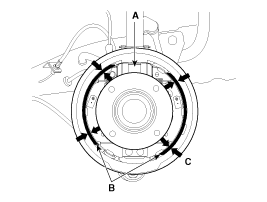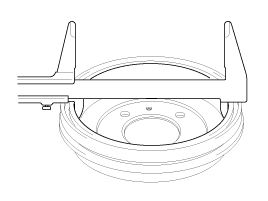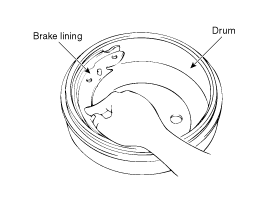 Hyundai Accent: Inspection
Hyundai Accent: Inspection
|
|
| 1. |
Raise the rear of the vehicle, and make sure it is securely supported.
|
| 2. |
Release the parking brake, and remove the rear brake drum.
|
| 3. |
Check the wheel cylinder (A) for leakage.
|
| 4. |
Check the brake linings (B) for cracking, glazing, wear, and contamination.
|
| 5. |
Measure the brake lining thickness (C).Measurement does not include
brake shoe thickness.
|
| 6. |
If the brake lining thickness is less than the service limit,
replace the brake shoes as a set.
|
| 7. |
Check the bearings in the hub unit for smooth operation. If it
requires servicing, replace it.
|
| 8. |
Measure the inside diameter of the brake drum with inside vernier
calipers.
|
| 9. |
If the inside diameter of the brake drum is more than the service
limit, replace the brake drum.
|
| 10. |
Check the brake drum for scoring, grooves, and cracks.
|
| 11. |
Inspect the brake lining and drum for proper contact.
|
| 12. |
Inspect the wheel cylinder outside for excessive wear and damage.
|
| 13. |
Inspect the backing plate for wear or damage.
|
 Installation
Installation
•
Do not spill brake fluid on the vehicle: it may damage
the paint; if brake fluid does conta ...
See also:
Rear Seat. Components and
Components Location
Components
1. Headrest [RH]
2. Rear seat back cover [RH]
3. Rear seat back frame assembly [RH]
4. Rear back cover [RH]
5. Headrest [Center]
6. Headrest [LH]
7 ...
1. Crankcase emission control system
The positive crankcase ventilation system is employed to prevent air pollution
caused by blow-by gases being emitted from the crankcase. This system supplies fresh
filtered air to the crankcase th ...
Purge Control Solenoid
Valve (PCSV). Schematic Diagrams
Circuit Diagram
(M/T)
(A/T)
...
Hyundai Accent Manuals
- Hyundai Accent 2017-2022 Service Manual
- Hyundai Accent 2010-2025 Owners Manual
- Hyundai Accent 2010-2025 Service Manual
© 2011-2025 Copyright www.hamanual.com




